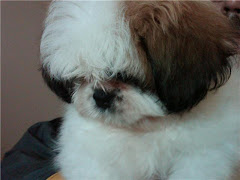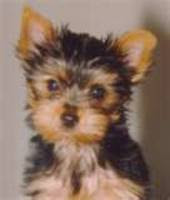
(GiGi 2007)
mati poo (alex pic).
Your new puppy wants to please you. Its your job to teach it what’s expected and reward it for good behavior. There are three factors: its ability to control its bowels and bladder, its sense of home and toilet areas, and how to communicate what is acceptable behavior for your pet.
Females are generally easier to train than males. They don’t lift their legs to urinate on shrubs and objects to mark territory. Female urine creates problems if the dog is “IN HEAT”, as this condition attracts male dogs. When the female urinates, she is generally done. When the male urinates, he does so a little at a time so he can mark numerous areas.
Larger breeds are generally easier to train than smaller breeds. Hounds are notoriously slow to housebreak, while working and sporting breeds are easier, as they have a strong desire to please.
It’s important to have realistic expectations. The animal is taken to a new home, surrounded by strange new smells, people, and places. It needs time to adjust to your home, a new diet, and the stress of moving.
Scents left behind by a previous dog may cause the new puppy to relieve himself.
Plan to get a new puppy when you have time to play and work with it. Before bringing a new puppy home, prepare a small pen or enclosure. The Kitchen is a good choice, as this is an active place and helps the puppy from feeling isolated, and it has floors which are usually easy to clean. Kitchens may have an outside door which help to quickly move the animal to the “outdoors” if nature calls.
Puppies are trained by their mothers to use non nest areas to relieve themselves. Learning where its all right to go is accomplished by experience and practice. Training is best done by clear, consistent, and persistent communications between the owner and the dog.
Puppies generally respect their sleeping areas and won’t relieve themselves in their bed or nest and then sleep in it. A pup might make a mistake the first night, but not likely on the second.
A sleeping box, carriers are ideal, with a door or lid and adequate ventilation should be provided. The box should only be large to turn around in, stretch, or stand up in. A larger carrier allows the pup to relieve itself in one end of the box and sleep in the other, defeating your training.
Close confinement is the quickest method to teach the animal proper habits. If it has the”run of the house”, it learns to soil floors and carpets -- habits that will have to be dealt with, in addition to housebreaking. If you play often with the pup in his confined area and spend time with him when outside to eliminate, he wont suffer from confinement. A period of up to two weeks of housebreaking and close supervision beats years of frustration if lessons aren’t learned.
If the pup is at least 10 to 12 weeks old, begin training immediately when you arrive home. Develop a routine that allows the pup to please you, while learning acceptable behavior. A pup can voluntary void at 4 to 6 weeks of age, however at less than 4 months of age it cannot physically control waste functions for more than a few hours at a time. Eight weeks is about the youngest any puppy will begin to respond to housetraining. Each pup will have its own abilities ==some may train earlier and some later than four months of age. Expect mistakes at first, as pups can”t go very long between toilet trips.
Limit water, provide it three to five times a day. After every meal take the puppy outside for a walk until he relieves himself. Make sure its in the right place at the right time. Be consistent -- Even if the weather is bad, keep the routine of feeding on time and then take the dog outside to relieve himself. Inconsistency will confuse the pup and lengthen the period of training. Young puppies need food three or four times a day.
Take him outside first thing in the morning, after every meal, just before bedtime, and after mid day naps. Trips outside are warranted after periods of excitement or exercise. If he starts sniffing the floor, circling as if trying to squat, if he becomes restless, or if he appears to be looking for a place to do his work. Stay outside until you are sure he has eliminated When the dog responds correctly be sure to give it lavish praise.
It’s important to designate a particular area for the animal to relieve itself. Pick a secluded area of the garden and mark it with a rag or paper towel you used to clean up an inside mistake. The pup will notice the smell, think he used the area before, and probably get the idea of what’s supposed to happen next. Take the puppy to a different “usable” area of the yard so it doesn’t become fixed on one spot and refuse to urinate anywhere else. Let him know its all right to relieve himself wherever you lead him.
Be Consistent = Try to feed every day at the same times. This helps the puppy know what to expect. As he grows older he will be able to contain himself for longer periods and outings can be reduced to about four a day, but let him work slowly up to that goal. Remember small puppies need 4 feeds a day
Punishing a very young puppy is no more reasonable than it would be for a baby in diapers. Scold him and he’ll probably forget about it by the next time he has to go. Try and housebreak by prevention -- teach good manners, while not giving the pup a chance to form bad habits.
It’s absurd to rub a pup’s nose in his feces or urine in an attempt to discipline him. The puppy’s nose didn’t create the mess. It’s useless to strike the animal as punishment, as this only upsets the animal and makes it far more likely to recreate the problem.
When mistakes occur, clean up immediately. On uncarpeted floors blot up as much moisture as possible with paper towels or rags (save the rag for a scent mark for outside use), wash the spot with soap and water, wipe with a solution of one cup white vinegar to 2 cups water, then with clear water. Work from the outside towards the centre. Spray with an odor neutralizer (available at most pet stores) to remove the odor and reduce the chance the animal will return to the same spot.
On carpets or rugs, blot up as much as possible, wash with soap and water, rinse thoroughly, then wash with one cup vinegar in 5 cups water. Follow with clear, water rinses, blot again, and spray with an odor neutralizer.
Disciplining a puppy after the event has happened is almost always a waste of time, as it forgets its association with the mess. Low level disapproval, such as “What did you do? Bad Dog Bad Boy!” is all that’s needed if he acts guilty. Take the dog immediately to the designated toilet area and remember to reward the animal for correct actions.
If you leave the animal, confine it. Exercise Pens are great. As soon as you get home, take it outside until it “performs correctly and give lots of praise. When you are home, keep the pup in view. An unsupervised pup is likely to have an accident. Housebreaking takes from 4 days to 2 weeks.
Don’t give food or water within 2 -3 hrs of bedtime. A high quality, low bulk, dry food diet will help produce smaller, less frequent, and more reliable bowel movements. Super-premium feeds are low in added salt, which decreases the need for extra water and later urination. Lower quality feeds normally have higher salt levels and increased thirst, with additional water intake and urination.
 visit my page:http://kiwiskennels.jimdo.com/links-address/
visit my page:http://kiwiskennels.jimdo.com/links-address/


















